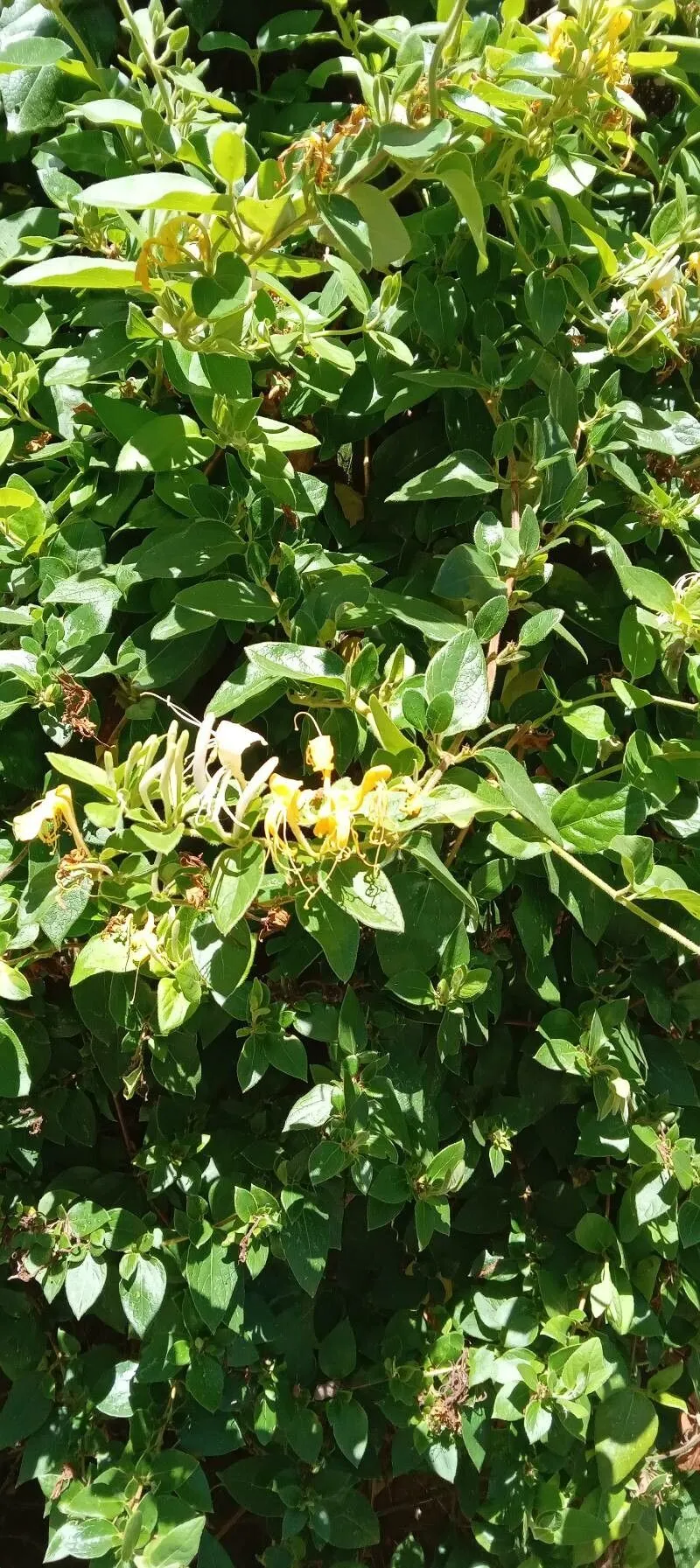
Author: Thunb.
Bibliography: J.A.Murray (ed.), Syst. Veg. ed. 14: 216 (1784)
Year: 1784
Status: accepted
Rank: species
Genus: Lonicera
Vegetable: False
Observations: China to Temp. E. Asia
Japanese honeysuckle, also known scientifically as Lonicera japonica, is a vigorous, fast-growing vine renowned for its sweetly scented flowers and adaptability. Authored by the distinguished botanist Thunberg and first documented in J.A. Murray’s “Systema Vegetabilium” 14th edition in 1784, this plant has earned its place in gardens and wild landscapes alike due to its resilient nature and ornamental appeal.
Native to China and temperate regions of East Asia, Japanese honeysuckle thrives in a variety of environments, from forest edges to urban settings. It is a member of the Caprifoliaceae family, which is known for its flowering plants that often share similar fragrant and tubular blooms.
The plant features long, twining stems that can climb on structures or sprawl across the ground. Its opposite, ovate leaves are semi-evergreen to evergreen depending on the climate, providing year-round greenery. The most striking feature of Japanese honeysuckle is its flowers. Blooming from late spring through summer, the flowers start as pure white and gradually turn to a creamy yellow as they age. This color change occurs concurrently with an increase in the intensity of their sweet fragrance, making them a magnet for pollinators such as bees, butterflies, and hummingbirds.
One of the reasons for its widespread use is its hardy nature; Japanese honeysuckle can tolerate a wide range of soils and environmental conditions, making it an ideal choice for covering fences, trellises, and arbors or for use as ground cover. However, this same adaptability allows it to become invasive in some regions, outcompeting native flora and altering ecosystems. Therefore, it is crucial to manage its growth responsibly, ensuring it does not spread uncontrollably.
Despite its potential invasiveness, Japanese honeysuckle is appreciated in horticulture for its aesthetic appeal and fragrance. Gardeners often plant it where its intoxicating aroma and vibrant flowers can be most enjoyed. With a bit of care and maintenance, this historical and botanically noteworthy vine can provide considerable charm and utility to garden landscapes.
Eng: chinese honeysuckle, gold-and-silver-flower, japanese honeysuckle, yellow japanese honeysuckle
Fra: chèvrefeuille asiatique, clématite du japon, chèvrefeuille du japon
Deu: japanische heckenkirsche, japanisches geißblatt
Nld: japanse kamperfoelie
Spa: madreselva
Swe: slingertry
Nob: japankaprifol
Nno: japankaprifol
Cym: gwyddfid japan
En: Japanese honeysuckle, Gold-and-silver-flower, Chinese honeysuckle, Yellow Japanese honeysuckle, Hall’s honeysuckle, Honeysuckle (Japan), Honeysuckle, Ribbon fern
Ca: Lligabosc japonès
Zh: Ren dong, Jin yin hua
Nl: Japanse kamperfoelie
Fr: Clématite du Japon, Chèvrefeuille asiatique, Chèvrefeuille du Japon
De: Japanisches Geißblatt, Japanische Heckenkirsche, Japanisches Geissblatt
It: Caprifoglio giapponese
Ja: Nindō, Suikazura
Nb: Japankaprifol
Nn: Japankaprifol
Pt: Madressilva-do-Japão, Madressilva
Es: Madreselva, Madreselva del Japón
Sv: Slingertry
Cy: Gwyddfid Japan
Taken Jun 4, 2018 by jose (cc-by-sa)
Taken May 18, 2017 by jeannin (cc-by-sa)
Taken Jan 10, 2018 by Beverly Patrick (cc-by-sa)
Taken May 8, 2017 by Pep Sole (cc-by-sa)
Taken May 8, 2017 by Pep Sole (cc-by-sa)
Taken Nov 23, 2022 by Acosta García Isabel (cc-by-sa)
Taken Nov 23, 2022 by Acosta García Isabel (cc-by-sa)
Taken Feb 4, 2022 by Fabrice Rubio (cc-by-sa)
Taken Nov 23, 2022 by Acosta García Isabel (cc-by-sa)
Taken Sep 26, 2019 by Anne Pieussergues (cc-by-sa)
Taken Jul 12, 2022 by Fabrice Rubio (cc-by-sa)
Taken Nov 21, 2018 by Manu Pacha (cc-by-sa)
Taken Sep 26, 2019 by Anne Pieussergues (cc-by-sa)
Taken Dec 13, 2020 by Maxence Drouet (cc-by-sa)
Taken Feb 18, 2019 by Jessica Stone (cc-by-sa)
Taken Jan 10, 2022 by Fabrice Rubio (cc-by-sa)
Taken Jul 20, 2021 by Sabin Poenariu (cc-by-sa)
Taken Feb 4, 2022 by Fabrice Rubio (cc-by-sa)
Taken Nov 13, 2022 by Fozame (cc-by-sa)
Taken Jul 12, 2022 by Fabrice Rubio (cc-by-sa)
Taken May 5, 2017 by Tela Botanica − Florent BECK (cc-by-sa)
Taken Jun 23, 2022 by Pl@ntNet (cc-by-sa)
Taken May 22, 2021 by Éric MARTINET (cc-by-sa)
Taken Dec 28, 2021 by Villena Rojas Marcelo (cc-by-sa)
Taken Jun 22, 2020 by Dieter Wagner (cc-by-sa)
© copyright of the Board of Trustees of the Royal Botanic Gardens, Kew.
© copyright of the Board of Trustees of the Royal Botanic Gardens, Kew.
© copyright of the Board of Trustees of the Royal Botanic Gardens, Kew.
Taken Jun 15, 2021 by Barnabas Prouse (cc-by-sa)
Taken Mar 19, 2015 by Tela Botanica − Liliane Roubaudi (cc-by-sa)
Taken Jul 27, 2013 by EOL − Maurice (cc-by-nc)
Taken Apr 21, 2020 by Klaudia Bernacka (cc-by-sa)
Taken May 21, 2019 by Jordan Whitman (cc-by-sa)
Growth form: Stoloniferous
Growth habit: Vine
Growth rate: Rapid
Ph maximum: 8.3
Ph minimum: 4.9
Light: 5
Atmospheric humidity: 6
Soil nutriments: 4
Family: Myrtaceae Author: (F.Muell.) K.D.Hill & L.A.S.Johnson Bibliography: Telopea 6: 402 (1995) Year: 1995 Status:…
Family: Rubiaceae Author: Pierre ex A.Froehner Bibliography: Notizbl. Bot. Gart. Berlin-Dahlem 1: 237 (1897) Year:…
Family: Sapindaceae Author: Koidz. Bibliography: J. Coll. Sci. Imp. Univ. Tokyo 32(1): 38 (1911) Year:…
Family: Asteraceae Author: A.Gray Bibliography: Pacif. Railr. Rep.: 107 (1857) Year: 1857 Status: accepted Rank:…
Family: Fabaceae Author: Medik. Bibliography: Vorles. Churpfälz. Phys.-Ökon. Ges. 2: 398 (1787) Year: 1787 Status:…
Family: Aspleniaceae Author: (Cav.) Alston Bibliography: Bull. Misc. Inform. Kew 1932: 309 (1932) Year: 1932…